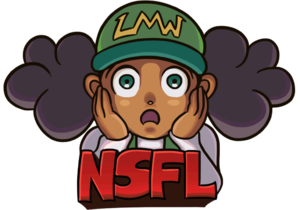User: Catysnowblaster5000/Crimewatch: Difference between revisions
No edit summary |
m (SenaUW moved page Crimwatch(Lost Singaporean TVseries' episodes); 1986-1992 to User:Catysnowblaster5000/Crimewatch without leaving a redirect: If you're going to submit a blatant work in progress, at least make it a sandbox under your userpage) |
(No difference)
| |
Revision as of 15:18, 16 February 2024
Singapore Crimewatch 1986 Intro title screen(Episodes from around 1986-1992 are completely lost)
Status: Lost
This article has been tagged as Needing work due to its this article is not finished yet,I'm writing it during my free time.
This article has been tagged as NSFL due to its older episodes contain weapons and homicide.Article has images of blood and violence for referencing purposes.
Crimewatch is a Singaporean television series(not to be confused with Crimewatch UK) produced by the "Singapore Police Force" and the programme is broadcast on television by "MediaCrop TV Singapore".The documentary-drama focuses on how actual Police officers who had attended with a real case had done their part by also reconstructing the scenes in the shows.In older episodes,the programme may also promote and showcase the jobs or behind-the-scenes movements of Singapore police officers.Crime Watch’s modus operandi would typically comprise the following:
(1) sourcing of crimes for featuring in the next episode; (2) scripting for filming; (3) filming on scene (no sets were used); (4) post-production work involving stitching, editing and sound�editing; (5) internal reviewing; (6) re-editing work including narrating and sound-mixing; (7) external screen tests; (8) actual broadcasting on national TV; (9) manning the Crime Watch's hotline to receive and act upon tip-offs; and (10) collating data on viewership figures for the episode screened in different languages(for example,"神之以法"--Chinese-dubs)
The idea of Crime Watch was conceived when two unnamed senior police officers from the Criminal Investigation Department after learning of the successes of "Crimestoppers" in the United States and Canada and "Crime Watch"(警訊) in Hong Kong. These police-sponsored televisual productions were broadcasted on free-to-air public television networks in the respective countries with the aim of seeking public assistance in the solving of criminal cases with little or no leads. Buoyed by the popularity of these foreign programmes and needing to secure the help of the public in the prevention and solving of crimes, the leadership of the SPF actively pursued the option of starting a local variant of Crime Watch in Singapore.
The first few iterations of the 20-odd minute71 docu-drama focused exclusively on public appeal and crime prevention. Typically, a re construction of an unsolved case would be staged by a motley cast of former and currently-serving police officers supplemented by semi-professional actors supplied by Mediacorp, and this would be followed by an emotive appeal for eye-witnesses to contact the police non-emergency line with the assurance that all identities of tipsters would be kept strictly confidential. Crime prevention segments featured basic crime prevention advisories.Such cases are:robbery in homes, theft of and from vehicles, snatch theft, outrage of modesty and housebreaking,the murder of an individual.These segments will consist of a mixture of a short-length re-enactment of solved or unsolved crimes, advisories given by the on-screen presenter(Police officer and Host for the show), interviews with members of partner organisations on crime prevention,and presentation slides highlighting crime prevention mnemonics in bullet-point form.
The charge of indifference was levied against the population in the pilot episode of Crime Watch (Episode 1;1986). A 20-year old Chinese out on a romantic date was abruptly, brutally and fatally physically assaulted by a group of youths at a public area next to the void deck of a public housing flat. Despite the occurrence of the crime at the coordinates of public and prime-time visuality, no witnesses had yet come forward to provide the police with workable leads on the case. This public passivity necessitated steps taken by the police to re-trace the footsteps of the victim on screen. The producers opted for a realistic reconstruction of the scenes leading up to the commission of crime, detailing with disturbing realism how a romantic landscape was fractured and transformed into a landscape of death in the space of a night. The re-enactment ended with a cut to a real-life interview with the victims’ grieving parents who emotively appeal on behalf of the police for eye-witnesses to come forward. The civic outrage at witnessing this public inaction subsequently translated to several calls to the police hotline following the broadcast of the pilot, which eventually led to the arrests of the culprits. This episode provided not only a glimpse of the potential investigative successes of an extended run of Crime Watch, but also provided a window of understanding to the authorities on the need for civic engagement. Additionally, it supplied the basic framework for the reconstruction of unsolved cases, which would be re-used for the remainder of the first phase of Crime Watch. <Source:(Crimewatch 25th Anniversary Special) on MeWatch> File:Gang of youths approaching Ng.jpeg|The gang of youths approaching the couple(The victim,Ng and his girlfriend) (1986 ep1) File:1987EpoisoFile-Ng being chased by the gang of Youths.jpeg|Ng being chased by the gang of youths,while his girlfriend escaped the scene(1986 ep1) File:1986 Ng case1.jpeg|One of the Police host for the pilot episode(1986 ep1) File:Ng identity1986CW.jpeg|The victim,Ng's,identity featured on the pilot to appeal for information(1986 ep1) ile:Ng case 1986 2.jpeg|Another police host(1986 ep1) Example.jpg|Caption2 Example.jpg|Caption2 Example.jpg|Caption2 Example.jpg|Caption2 </gallery>


